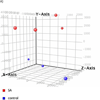Particulate matter from Saudi Arabia induces genes involved in inflammation, metabolic syndrome and atherosclerosis
- PMID: 24839929
- PMCID: PMC4233653
- DOI: 10.1080/15287394.2014.892446
Particulate matter from Saudi Arabia induces genes involved in inflammation, metabolic syndrome and atherosclerosis
Abstract
Airborne particulate matter (PM) exposure is a major environmental health concern and is linked to metabolic disorders, such as cardiovascular diseases (CVD) and diabetes, which are on the rise in the Kingdom of Saudi Arabia. This study investigated changes in mouse lung gene expression produced by administration of PM10 collected from Jeddah, Saudi Arabia. FVB/N mice were exposed to 100 μg PM10 or water by aspiration and euthanized 24 h later. The bronchoalveolar lavage fluid (BALF) was collected and analyzed for neutrophil concentration and tumor necrosis factor (TNF)-α and interleukin (IL)-6 levels. RNA was extracted from lungs and whole transcript was analyzed using Affymetrix Mouse Gene 1.0 ST Array. Mice exposed to PM10 displayed an increase in neutrophil concentration and elevated TNF-α and IL-6 levels. Gene expression analysis revealed that mice exposed to PM10 displayed 202 genes that were significantly upregulated and 40 genes that were significantly downregulated. PM10 induced genes involved in inflammation, cholesterol and lipid metabolism, and atherosclerosis. This is the first study to demonstrate that Saudi Arabia PM10 increases in vivo expression of genes located in pathways associated with diseases involving metabolic syndrome and atherosclerosis.
Figures




Similar articles
-
In Vivo Exposures to Particulate Matter Collected from Saudi Arabia or Nickel Chloride Display Similar Dysregulation of Metabolic Syndrome Genes.J Toxicol Environ Health A. 2015;78(23-24):1421-36. doi: 10.1080/15287394.2015.1095689. J Toxicol Environ Health A. 2015. PMID: 26692068 Free PMC article.
-
Beijing ambient particle exposure accelerates atherosclerosis in ApoE knockout mice.Toxicol Lett. 2013 Nov 25;223(2):146-53. doi: 10.1016/j.toxlet.2013.09.004. Epub 2013 Sep 14. Toxicol Lett. 2013. PMID: 24045146
-
The acute toxic effects of particulate matter in mouse lung are related to size and season of collection.Toxicol Lett. 2011 May 10;202(3):209-17. doi: 10.1016/j.toxlet.2011.01.031. Epub 2011 Mar 1. Toxicol Lett. 2011. PMID: 21371539
-
The effect of composition, size, and solubility on acute pulmonary injury in rats following exposure to Mexico city ambient particulate matter samples.J Toxicol Environ Health A. 2014;77(19):1164-82. doi: 10.1080/15287394.2014.917445. J Toxicol Environ Health A. 2014. PMID: 25119738
-
Outdoor particulate matter (PM) and associated cardiovascular diseases in the Middle East.Int J Occup Med Environ Health. 2015;28(4):641-61. doi: 10.13075/ijomeh.1896.00186. Int J Occup Med Environ Health. 2015. PMID: 26216305 Review.
Cited by
-
Environmental mixtures and body mass index in two prospective US-based cohorts of female nurses.J Hazard Mater. 2024 Dec 5;480:135794. doi: 10.1016/j.jhazmat.2024.135794. Epub 2024 Sep 10. J Hazard Mater. 2024. PMID: 39265401
-
Synergistic or Antagonistic Health Effects of Long- and Short-Term Exposure to Ambient NO2 and PM2.5: A Review.Int J Environ Res Public Health. 2022 Oct 28;19(21):14079. doi: 10.3390/ijerph192114079. Int J Environ Res Public Health. 2022. PMID: 36360958 Free PMC article. Review.
-
Cigarette side-stream smoke lung and bladder carcinogenesis: inducing mutagenic acrolein-DNA adducts, inhibiting DNA repair and enhancing anchorage-independent-growth cell transformation.Oncotarget. 2015 Oct 20;6(32):33226-36. doi: 10.18632/oncotarget.5429. Oncotarget. 2015. PMID: 26431382 Free PMC article.
-
A common functional variant on the pro-inflammatory Interleukin-6 gene may modify the association between long-term PM10 exposure and diabetes.Environ Health. 2016 Feb 24;15:39. doi: 10.1186/s12940-016-0120-5. Environ Health. 2016. PMID: 26911440 Free PMC article.
-
Metabolic Syndrome and Air Pollution: A Narrative Review of Their Cardiopulmonary Effects.Toxics. 2019 Jan 30;7(1):6. doi: 10.3390/toxics7010006. Toxics. 2019. PMID: 30704059 Free PMC article. Review.
References
-
- Afridi HI, Kazi TG, Kazi N, Kandhro GA, Baig JA, Jamali MK, Arain MB, Shah AQ, Shah F, Khan S, Kolachi NF. Association of environmental toxic elements in biological samples of myocardial infarction patients at different stages. Biol Trace Elem Res. 2011;141:26–40. - PubMed
-
- Al-Malki JS, Al-Jaser MH, Warsy AS. Overweight and obesity in Saudi females of childbearing age. Int J Obes Relat Metab Disord. 2003;27:134–139. - PubMed
-
- Al-Othaimeen AI A-NM, Osman AK. Obesity: an emerging problem in Saudi Arabia. Analysis of data from the National Nutrition Survey. East Mediterr Health J. 2007;13:441–448. - PubMed
Publication types
MeSH terms
Substances
Grants and funding
LinkOut - more resources
Full Text Sources
Other Literature Sources
Medical
